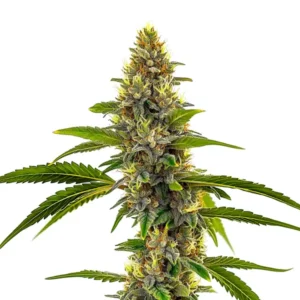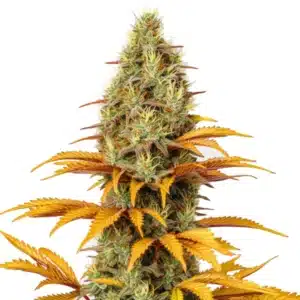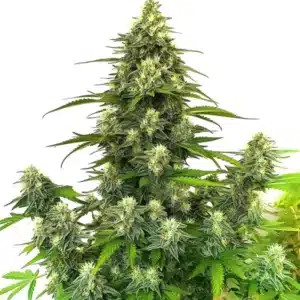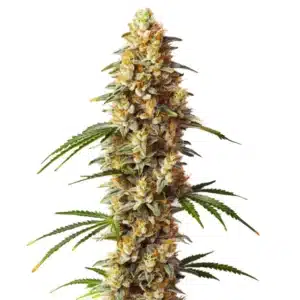When growing autoflowers, optimizing DLI (Daily Light Integral) is one of the most important factors for success. DLI for autoflowers isn’t only about providing light; it’s about ensuring the right amount of light is delivered consistently for your plants to thrive. By mastering bl, you can greatly increase your autoflower yields, improve bud quality, and create a more efficient growing environment.
The Significance of DLI for Autoflowers
For those new to the concept, DLI might sound technical, but it’s a fundamental aspect of growing cannabis, especially autoflowers. Why DLI autoflowers matters and how it impacts your plants is the first step toward unlocking their full potential.
What is DLI and How Does It Impact Autoflowers?
DLI, or Daily Light Integral, refers to the total amount of light a plant receives over a 24-hour period. It’s measured in moles of photons per square meter per day (mol/m²/day). In simpler terms, DLI quantifies the cumulative amount of light energy that hits your plants each day.
For autoflowers, which have a predetermined lifecycle, DLI is particularly crucial. These plants don’t rely on light cycles to trigger flowering; instead, they move through their life stages based on time. This means that the amount of light they receive each day directly influences their growth rate, bud development, and overall health.
Autoflowers are known for their speed and resilience, but they still require optimal light conditions to reach their full potential. If the DLI is too low, your plants may struggle to photosynthesize efficiently, leading to slower growth and smaller yields. On the other hand, if the DLI is too high, it can stress the plants, causing issues like light burn or nutrient deficiencies. Striking the right balance with DLI for autoflowers is essential for achieving a bountiful harvest. A great example is Fat Bastard Auto, an autoflowering strain that thrives when provided with ideal light intensity and care, delivering impressive yields and robust growth.
How DLI Impacts Cannabis Growth
DLI plays a pivotal role in the photosynthesis process, which is how plants convert light into energy. In cannabis cultivation, this energy is used to fuel the growth of leaves, stems, and, most importantly, buds. For autoflowers, maintaining an optimal DLI throughout their lifecycle ensures that they have enough energy to develop robust structures and produce dense, resinous flowers.
Unlike photoperiod plants, which can have their light exposure manipulated to extend the vegetative phase, autoflowers have a fixed timeframe. This makes DLI management even more critical. During the vegetative stage, an optimal DLI promotes vigorous growth, setting the foundation for a productive flowering phase. As the plants transition to flowering, adjusting the DLI to suit their changing needs helps maximize bud production and potency.
DLI in cannabis growth enables growers to optimize their lighting setups, making sure that autoflowers receive the ideal light levels at every stage of development. This approach not only boosts yields but also improves the overall quality of the harvest.
Why DLI Matters More for Autoflowers
Autoflowers are unique in their growing requirements, and this uniqueness makes DLI even more important for them compared to photoperiod strains. The fixed lifecycle of autoflowers means that every day counts. Unlike photoperiod plants that can be kept in the vegetative stage for as long as needed, autoflowers transition to flowering on their own schedule, typically within 2-4 weeks after germination.
Because of this fixed timeline, maximizing the efficiency of light delivery through proper DLI management is crucial. If the DLI is inadequate during the early stages, the plants may not develop the necessary structure to support heavy bud production later on. Conversely, if the DLI is too intense during the flowering stage, it can lead to issues like foxtailing, where the buds stretch and lose density.
For growers aiming to optimize their yields and quality, learn DLI for autoflowers and how to adjust it based on the plant’s stage of growth is essential. Additionally, referencing an autoflower DLI chart can help growers maintain consistent light levels throughout the lifecycle. This knowledge allows you to provide your plants with exactly what they need, when they need it, leading to healthier plants and more abundant harvests.

Promos & Deals
Calculating the Optimal DLI for Autoflowers
Once you understand the importance of DLI, the next step is to calculate the optimal levels for your autoflowers. Several factors influence the DLI requirements, and knowing how to measure and adjust these can make a significant difference in your grow.
Factors That Influence DLI Requirements
Several factors affect the DLI your autoflowers need to thrive. These include the intensity and duration of light exposure, the stage of growth, and the specific strain of autoflower you’re growing.
Light intensity, measured in micromoles per square meter per second (µmol/m²/s), directly impacts DLI. The stronger the light, the higher the DLI. However, the duration of light exposure also plays a role. For example, a light that provides 500 µmol/m²/s for 12 hours will result in a different DLI compared to the same light running for 18 or 24 hours.
The stage of growth is another critical factor. Autoflowers typically require a higher DLI during the vegetative stage to support rapid growth and development. As they transition to flowering, the DLI can be adjusted to focus more on bud development and resin production. Additionally, different autoflower strains may have varying DLI needs based on their genetics. Some strains might thrive under higher light levels, while others prefer more moderate exposure.
Environmental conditions, such as temperature and humidity, also influence how plants utilize light. For instance, in cooler environments, plants may require a slightly higher DLI to compensate for slower metabolic processes.
How to Measure DLI in Your Grow Space
Measuring DLI in your grow space is essential to ensure that your autoflowers are receiving the right amount of light. Using an autoflower DLI chart can simplify this process, offering a clear visual representation of optimal light levels for each growth stage. While it might sound complicated, with the right tools and knowledge, it’s a straightforward process.
To measure DLI, you’ll need a PAR (Photosynthetically Active Radiation) meter, which measures the light intensity in your grow space. PAR meters provide readings in µmol/m²/s, which you can then use to calculate DLI.
Here’s a simple formula to calculate DLI: DLI=Light Intensity (µmol/m²/s)×Hours of Light per Day×3600 seconds1000000\text{DLI} = \text{Light Intensity (µmol/m²/s)} \times \text{Hours of Light per Day} \times \frac{3600 \text{ seconds}}{1000000}DLI=Light Intensity (µmol/m²/s)×Hours of Light per Day×10000003600 seconds
For example, if your light intensity is 400 µmol/m²/s and your plants receive 18 hours of light per day: DLI=400×18×36001000000=25.92 mol/m²/day\text{DLI} = 400 \times 18 \times \frac{3600}{1000000} = 25.92 \text{ mol/m²/day}DLI=400×18×10000003600=25.92 mol/m²/day
This calculation gives you the total DLI your plants receive each day. By adjusting the light intensity or duration, you can fine-tune the DLI to match the optimal levels for your autoflowers.
Determining the Ideal DLI for Different Growth Stages
The ideal DLI for autoflowers varies depending on the stage of growth. During the seedling stage, a lower DLI is sufficient, typically around 10-15 mol/m²/day. This gentle light level encourages healthy root development without overwhelming the young plants.
As the plants enter the vegetative stage, they require more light to support rapid growth. Increasing the DLI to around 20-30 mol/m²/day ensures that your autoflowers develop strong stems and a robust canopy. This is the stage where the plants build their structure, and adequate light is crucial for maximizing their potential.
When the plants transition to flowering, the focus shifts to bud development. At this stage, maintaining a DLI of 25-35 mol/m²/day can promote dense, resinous buds while preventing issues like light stress. However, it’s important to monitor your plants closely and adjust the DLI as needed based on their response.
By knowing the optimal DLI for each growth stage, you can provide your autoflowers with the exact light levels they need to thrive, resulting in higher yields and better-quality cannabis.
Maximizing Autoflower Growth with Proper DLI
Proper DLI management is key to maximizing the growth and yield of your autoflowers. DLI affects photosynthesis and bud development, you can make informed decisions about light schedules and other factors to optimize your grow.
How DLI Affects Photosynthesis and Bud Development
DLI directly influences the photosynthesis process, which is the foundation of all plant growth. During photosynthesis, plants convert light energy into chemical energy, which is used to fuel various growth processes, including leaf expansion, stem elongation, and bud formation.
For autoflowers, maintaining the right DLI ensures that photosynthesis occurs at an optimal rate, leading to vigorous growth and robust bud development. A higher DLI during the vegetative stage supports rapid leaf and stem growth, which is essential for creating a strong plant structure. As the plants transition to flowering, a consistent DLI promotes the production of dense, resinous buds.
However, it’s important to strike a balance. While increasing DLI can boost growth, too much light can lead to stress, nutrient deficiencies, and reduced bud quality. Monitoring your plants and adjusting the DLI based on their needs is essential for maximizing yields and ensuring a healthy grow.
Adjusting Light Schedules to Optimize DLI
One of the most effective ways to manage DLI for autoflowers is by adjusting your light schedules. Unlike photoperiod plants, autoflowers don’t rely on a specific light cycle to trigger flowering, which gives you more flexibility in how you manage light exposure.
Many growers use an 18/6 light schedule (18 hours of light followed by 6 hours of darkness) to provide a high DLI while giving the plants some rest time. This schedule is particularly effective during the vegetative stage, where the goal is to maximize growth. Some growers even opt for a 20/4 or 24/0 schedule to further increase DLI, though this can sometimes lead to diminishing returns if the plants become stressed.
During the flowering stage, maintaining an 18/6 schedule or slightly reducing the light exposure can help balance DLI, focusing the plant’s energy on bud development rather than vegetative growth. Adjusting the light intensity can also help fine-tune DLI, ensuring that your plants receive the optimal amount of light for each stage of growth.
By experimenting with different light schedules and monitoring your plants’ responses, you can find the ideal DLI that maximizes growth, yield, and bud quality.
Using DLI to Boost Yields in Autoflowers
Optimizing DLI is one of the most effective strategies for boosting yields in autoflowers. By ensuring that your plants receive the right amount of light throughout their lifecycle, you can maximize photosynthesis, promote healthy growth, and ultimately increase bud production.
One key aspect of using DLI to boost yields is consistency. Autoflowers thrive when they receive a steady and consistent light supply, which helps maintain optimal photosynthesis rates. This consistency is especially important during the critical stages of growth, such as the transition from vegetative growth to flowering.
Another important factor is light distribution. Ensuring that your light source provides even coverage across the entire canopy can help maximize DLI for all parts of the plant, leading to uniform growth and bud development. Using techniques like LST (low-stress training) to spread out the canopy can improve light penetration and further enhance DLI.
Finally, regular monitoring and adjustments based on your plants’ needs are crucial. By closely observing how your autoflowers respond to different DLI levels, you can fine-tune your lighting setup to achieve the best possible results, leading to larger, more resinous buds and higher overall yields.
DLI and Light Spectrum Considerations for Autoflowers
While DLI is a crucial factor in autoflower cultivation, the light spectrum also plays a significant role in how your plants grow and develop. How to balance DLI with the right light spectrum can further optimize your grow and improve the quality of your harvest.

Balancing DLI with Light Spectrum for Optimal Growth
DLI and light spectrum work hand in hand to influence the growth and development of autoflowers. While DLI determines the total amount of light your plants receive, the light spectrum affects how that light is utilized.
During the vegetative stage, blue light (400-500nm) is particularly important. Blue light promotes compact growth and enhances the development of strong, healthy leaves and stems. By providing a higher DLI with a focus on blue light, you can encourage robust vegetative growth in your autoflowers.
As your plants transition to flowering, red light (600-700nm) becomes more critical. Red light promotes flowering and bud development, leading to denser, more resinous buds. Balancing DLI with an increased proportion of red light during this stage helps optimize the flowering process and improves the quality of the final product.
Using full-spectrum LED grow lights that provide a balanced range of wavelengths can help ensure that your plants receive the optimal light spectrum throughout their lifecycle. By adjusting DLI and light spectrum in tandem, you can create an environment that supports vigorous growth and maximizes yields.
The Impact of Red and Blue Light on DLI
Red and blue light have different effects on plant growth, Knowing how they interact with DLI is key for optimizing your autoflower grow.
Blue light, with its shorter wavelengths, is absorbed more efficiently by chlorophyll, the pigment responsible for photosynthesis. This makes blue light particularly effective during the vegetative stage, where it helps promote leaf and stem growth. A higher DLI combined with blue light can lead to more compact, bushy plants that are better equipped to support heavy buds during the flowering stage.
Red light, on the other hand, has longer wavelengths and penetrates deeper into the plant canopy. This makes red light ideal for the flowering stage, where it promotes bud development and increases the production of essential oils and cannabinoids. By maintaining a high DLI with a focus on red light during flowering, you can encourage the growth of dense, resinous buds that are rich in flavor and potency.
Balancing red and blue light with the right DLI levels allows you to tailor your lighting setup to the specific needs of your autoflowers at each stage of growth. This not only improves overall plant health but also enhances the quality and quantity of your harvest.
Best LED Lights for Achieving Optimal DLI
Choosing the right LED lights is critical for achieving optimal DLI in your autoflower grow. Not all LED lights are created equal, and selecting the best ones can make a significant difference in your results.
When choosing LED lights for autoflowers, look for full-spectrum lights that provide a balanced range of wavelengths, including both blue and red light. Full-spectrum LEDs mimic natural sunlight, offering the wavelengths your plants need at each stage of growth.
Consider the light intensity and coverage area when selecting your LED lights. Higher-intensity lights can deliver a higher DLI, but it’s important to ensure even light distribution across your entire grow space. Lights with adjustable settings allow you to fine-tune both intensity and spectrum, giving you greater control over your DLI.
Brands known for quality and reliability, such as Spider Farmer, Mars Hydro, and HLG, offer LED grow lights that are specifically designed for cannabis cultivation. These lights are energy-efficient, durable, and capable of delivering the optimal DLI for autoflowers, helping you achieve the best possible results in your grow.

Troubleshooting Common DLI Issues in Autoflower Grows
Even with careful planning, you may encounter issues with DLI in your autoflower grow. Recognizing and addressing these problems early can prevent them from negatively impacting your plants’ health and yield.
Signs Your DLI is Too Low or Too High
One of the most common challenges growers face is determining whether their DLI is too low or too high. Both scenarios can cause issues, but they manifest in different ways.
If your DLI is too low, your autoflowers may exhibit slow growth, weak stems, and small, underdeveloped buds. The plants may stretch as they search for more light, leading to leggy growth and reduced overall vigor. In extreme cases, low DLI can result in a lackluster harvest with low potency and poor bud structure.
On the other hand, if your DLI is too high, the plants may show signs of light stress, such as leaf curling, bleaching, or burned tips. High DLI can also lead to nutrient deficiencies, as the plants’ metabolic processes accelerate beyond what their root system can support. In severe cases, overly intense light can stunt growth and reduce the quality of the final harvest.
Monitoring your plants closely and making adjustments to your lighting setup can help prevent these issues. If you notice signs of low DLI, consider increasing light intensity or extending the light exposure duration. Conversely, if the plants show signs of high DLI, reduce the light intensity or shorten the light cycle to give them time to recover.
How to Correct DLI Imbalances in Your Grow
Correcting DLI imbalances involves adjusting both the light intensity and duration to ensure your plants receive the optimal amount of light. The first step is to measure the current DLI in your grow space using a PAR meter, as discussed earlier.
If your DLI is too low, increasing the light intensity is often the most effective solution. However, be cautious not to increase it too quickly, as this can shock the plants. Gradually raise the intensity over several days, allowing the plants to acclimate to the higher light levels. Alternatively, you can extend the light cycle to increase the total DLI without altering the intensity.
If your DLI is too high, the opposite approach is needed. Start by lowering the light intensity or raising the lights higher above the canopy to reduce the overall exposure. Reducing the number of hours the lights are on each day can also help bring the DLI down to a more manageable level.
In some cases, adjusting the light spectrum can also help alleviate DLI-related issues. For example, reducing the proportion of blue light during the flowering stage can minimize light stress while maintaining a high overall DLI for bud development.
Maintaining Consistent DLI in Variable Environments
Maintaining consistent DLI autoflower can be challenging, especially in environments where temperature, humidity, or other factors fluctuate. However, consistency is key to ensuring your autoflowers thrive.
One strategy for maintaining consistent DLI is to use a programmable light timer that allows you to set precise light schedules. This ensures that your plants receive the same amount of light each day, regardless of external conditions.
In addition, consider using environmental controls such as thermostats, humidifiers, and dehumidifiers to stabilize the growing environment. By maintaining stable temperature and humidity levels, you can help your plants utilize the light they receive more efficiently, reducing the risk of stress and improving overall growth.
Monitoring tools such as PAR meters and data loggers can also help you track DLI and other environmental factors in real-time. By regularly checking these readings, you can make informed adjustments to your grow setup, ensuring that your autoflowers receive the consistent care they need to reach their full potential.
Comparing DLI for Autoflowers and Photoperiod Strains
While both autoflowers and photoperiod strains benefit from optimized DLI, there are important differences in how these two types of cannabis plants respond to light. These differences can help you tailor your approach to each type of plant.
Differences in Light Needs Between Autoflowers and Photoperiods
The most significant difference between autoflowers and photoperiod strains lies in their response to light cycles. Photoperiod plants rely on changes in light exposure to trigger flowering, typically requiring a shift from 18 hours of light to 12 hours as they transition from vegetative growth to flowering.
Autoflowers, on the other hand, do not depend on light cycles to flower. Instead, they progress through their growth stages based on time. This means that autoflowers can benefit from more consistent light exposure throughout their lifecycle, making DLI management particularly important.
While photoperiod plants can tolerate variations in DLI, particularly during the vegetative stage, autoflowers require more careful management. Their fixed lifecycle means that any deviation from the optimal DLI can have a more pronounced impact on their growth and yield.
How Autoflowers Respond to DLI Adjustments
Autoflowers are generally more resilient than photoperiod strains, but they still respond to DLI adjustments in specific ways. For instance, increasing the DLI during the vegetative stage can result in faster growth and a stronger plant structure, setting the stage for a more productive flowering phase.
During flowering, autoflowers may respond to a reduced DLI by focusing more energy on bud development rather than continued vegetative growth. This can lead to denser buds and higher resin production, enhancing the quality of the final harvest.
However, it’s important to note that autoflowers can also be more sensitive to sudden changes in DLI. Gradual adjustments are key to avoiding stress and ensuring that your plants remain healthy throughout their growth cycle.
Strategies for Balancing DLI Across Different Strain Types
When growing both autoflowers and photoperiod strains together, balancing DLI can be challenging but not impossible. The key is to find a middle ground that satisfies the needs of both types of plants.
One strategy is to set up separate grow areas with different light schedules and intensities tailored to each strain type. This allows you to optimize DLI for autoflowers while providing the specific light conditions that photoperiod strains require.
Alternatively, you can adjust the light height and intensity within a single grow space to create zones with varying DLI cannabis autoflower levels. Autoflowers can be placed in areas with higher light intensity, while photoperiod plants can be positioned where they receive a more moderate DLI.
By carefully managing the light environment, you can successfully grow both autoflowers and photoperiod strains side by side, each thriving under the conditions best suited to their needs.

FAQs
What is the optimal DLI for autoflowers during each growth stage?
The ideal Daily Light Integral (DLI) for autoflowers varies by growth stage. Seedlings thrive with a DLI of 10–15 mol/m²/day, while vegetative growth requires around 20–30 mol/m²/day to promote strong development. During flowering, maintain a DLI of 25–35 mol/m²/day to encourage dense, resin-rich buds. Adjusting DLI based on the plant’s life stage is key to maximizing yield and quality.
Why is DLI more important for autoflowers than photoperiod strains?
Unlike photoperiod strains, autoflowers don’t rely on light cycles to trigger flowering—they flower based on age. This fixed lifecycle makes every day of light exposure crucial. Proper DLI management ensures your autoflowers receive enough light energy to support healthy growth and optimal bud development throughout their limited timeframe.
How can I measure and adjust DLI in my autoflower grow setup?
To measure DLI, use a PAR meter to record light intensity (in µmol/m²/s), then calculate DLI using the formula:
DLI = Light Intensity × Light Hours × 3600 / 1,000,000
Adjust your DLI by changing light intensity, duration, or spectrum. For consistent results, consider using an autoflower DLI chart and full-spectrum LED grow lights designed for cannabis cultivation.
















